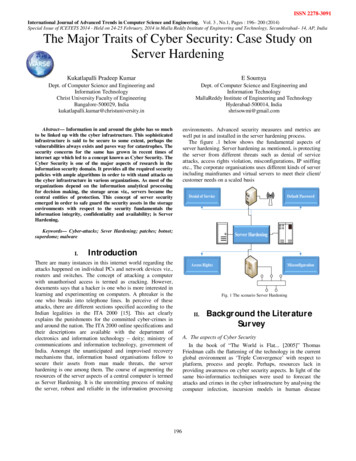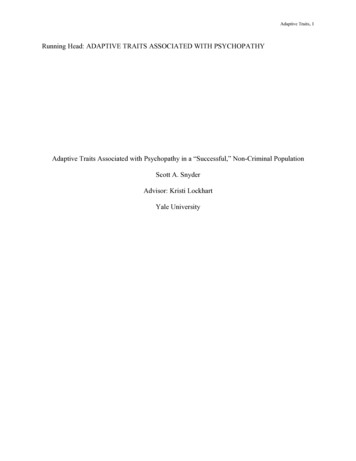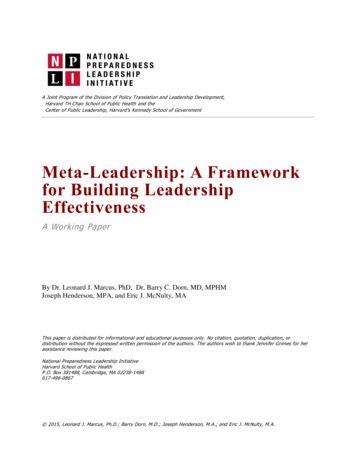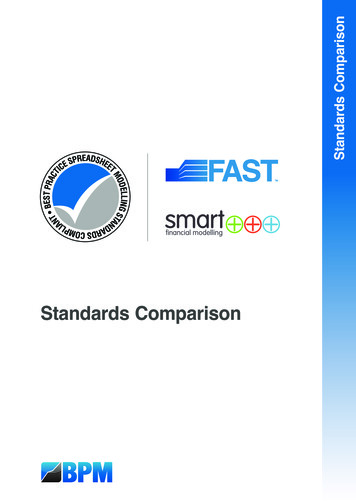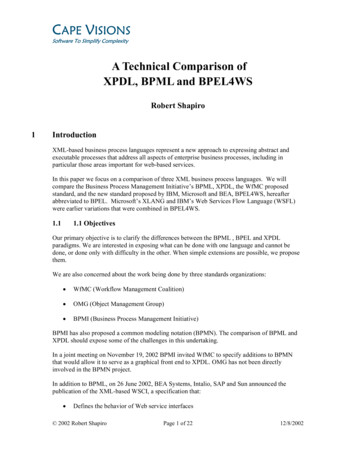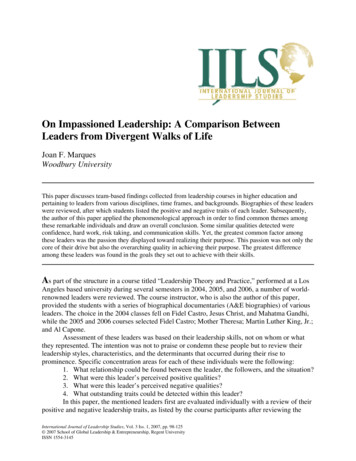
Transcription
On Impassioned Leadership: A Comparison BetweenLeaders from Divergent Walks of LifeJoan F. MarquesWoodbury UniversityThis paper discusses team-based findings collected from leadership courses in higher education andpertaining to leaders from various disciplines, time frames, and backgrounds. Biographies of these leaderswere reviewed, after which students listed the positive and negative traits of each leader. Subsequently,the author of this paper applied the phenomenological approach in order to find common themes amongthese remarkable individuals and draw an overall conclusion. Some similar qualities detected wereconfidence, hard work, risk taking, and communication skills. Yet, the greatest common factor amongthese leaders was the passion they displayed toward realizing their purpose. This passion was not only thecore of their drive but also the overarching quality in achieving their purpose. The greatest differenceamong these leaders was found in the goals they set out to achieve with their skills.As part of the structure in a course titled “Leadership Theory and Practice,” performed at a LosAngeles based university during several semesters in 2004, 2005, and 2006, a number of worldrenowned leaders were reviewed. The course instructor, who is also the author of this paper,provided the students with a series of biographical documentaries (A&E biographies) of variousleaders. The choice in the 2004 classes fell on Fidel Castro, Jesus Christ, and Mahatma Gandhi,while the 2005 and 2006 courses selected Fidel Castro; Mother Theresa; Martin Luther King, Jr.;and Al Capone.Assessment of these leaders was based on their leadership skills, not on whom or whatthey represented. The intention was not to praise or condemn these people but to review theirleadership styles, characteristics, and the determinants that occurred during their rise toprominence. Specific concentration areas for each of these individuals were the following:1. What relationship could be found between the leader, the followers, and the situation?2. What were this leader’s perceived positive qualities?3. What were this leader’s perceived negative qualities?4. What outstanding traits could be detected within this leader?In this paper, the mentioned leaders first are evaluated individually with a review of theirpositive and negative leadership traits, as listed by the course participants after reviewing theInternational Journal of Leadership Studies, Vol. 3 Iss. 1, 2007, pp. 98-125 2007 School of Global Leadership & Entrepreneurship, Regent UniversityISSN 1554-3145
INTERNATIONAL JOURNAL OF LEADERSHIP STUDIES99documentaries. Subsequently, the traits of these leaders are compared, in order to bringsimilarities and contradictions to the surface. Finally, a list is presented of traits that can beperceived as directions on the road to success, based on the presence of these traits among theleaders reviewed.PurposeThe purpose of studying these leaders was to detect a set of common factors among themin order to create a profile of important qualities needed in leadership. This, then, should also beconsidered the contribution of this study to leadership theory and practice.The choice of these particular leaders was based on the following factors: (a) they wereall familiar to the students in some way; (b) they had acquired world renown, whether positivelyor negatively; (c) these leaders harbor a timeless celebrity, as they remain well known in societyeven though some of them have long passed away; and (d) the availability of video materialabout these leaders in local libraries.Leadership Theories InvestigatedWhen reviewing the findings from this study, an interesting combination of leadershiptheories surfaced. The oldest theory, the leadership trait paradigm, was most prominent in thisstudy, which will become clear to the reader throughout this paper. In their explanation of thetrait theory of leadership, House and Aditya (1997) asserted, “A large number of personalcharacteristics [are] investigated such as gender, height, physical energy and appearance as wellas psychological traits and motives such as authoritarianism, intelligence, need for achievement,and need for power” (p. 410). Because the leaders in this study are all renowned individuals, thephysical aspects were left out of scope, but the psychological traits and motives received broadattention. The charisma theory, an element of the trait theory, is prominently present in thisstudy. “Charismatic leaders are exceptionally self-confident, are strongly motivated to attain andassert influence, and have strong conviction in the moral correctness of their beliefs” (House &Aditya, p. 416).The leader behavior paradigm also surfaces in this study, as various acts of the selectedleaders were reviewed and compared. “The initial guiding assumption of the behavioralparadigm [is] that there are some universally effective leader behaviors” (House & Aditya, 1997,p. 421).As the situation and the followers were also considered in this study, starting with point 1in the concentration areas (what relationship could be found between the leader, the followers,and the situation?), it can be confirmed that situational leadership theories also served ascontributing factors in the formulation of the findings, although not as profusely as trait andbehavior approaches. Northouse (2004) asserted, “The basic premise of the [situational] theory isthat different situations demand different kinds of leadership” (p. 87). The influence ofsituational theories is illustrated in this paper when presenting behaviors such as empathy andcommunication skills and is explicitly reviewed in the conclusive section of this paper.A recurring leadership style in this paper is the transformational leadership style which,according to Northouse (2004), is “one of the current approaches to leadership that has been thefocus of much research since the early 1980s” (p. 169). Northouse explained, “Transformationalleadership is a process that changes and transforms individuals. It is concerned with emotions,International Journal of Leadership Studies, Vol. 3 Iss. 1, 2007, pp. 98-125 2007 School of Global Leadership & Entrepreneurship, Regent UniversityISSN 1554-3145
Marques/INTERNATIONAL JOURNAL OF LEADERSHIP STUDIES100values, ethics, standards, and long-term goals, and includes assessing followers’ motives,satisfying their needs, and treating them as full human beings” (p. 169). Northouse continued,“Transformational leadership involves an exceptional form of influence that moves followers toaccomplish more than what is usually expected of them. It is a process that often incorporatescharismatic and visionary leadership” (p. 169). As an extension to the transformationalleadership style, inspirational and motivational leadership are also mentioned in this paper.Several authors (House & Aditya, 1997; Ilies, Judge, & Wagner, 2006) have consideredmotivational leadership an aspect of charismatic and transformational leadership.Leadership Focus of This PaperThe theoretical focus of this paper is based on the assumption that leaders are made whenindividuals work toward developing a certain set of qualities and behaviors and consider thecircumstances and followers at hand. As an extension to this assumption, the paper attempts todemonstrate that no single theory should be considered when reviewing leadership; differenttheories come into play in the development of a comprehensive picture of appropriate leadership.All theories have demonstrated their advantages and disadvantages over time, and it would bedeficient to focus on just one theory when studying a phenomenon as timeless and prominent asleadership.New Insights to be Gained From This PaperThis study does not only demonstrate that multiple theories need to be taken intoconsideration when one wants to draw useful conclusions about leadership, but it also reveals theimportant fact that leaders can utilize their skills, traits, and behaviors in positive and negativeways with equal success. The paper further illuminates that leadership requires a high level ofadaptability or flexibility from the leader, which demonstrates that leaders should also be awareof the fact that it would be inadequate to classify their leadership style within merely one theory.Although not extensively, the paper also mentions a not earlier explored fact about apossible negative relationship between leadership and family connectedness, which may be aninteresting topic for future research.MethodologyTo execute this study, the author of this paper used the phenomenological approach,which is qualitative in nature. “A phenomenological study describes the meaning of the livedexperiences for several individuals about a concept or the phenomenon” (Creswell, 1998, p. 51).The concept or phenomenon in this study was leadership. Students were asked to provideextensive answers to a set of questions, geared toward the four focus points listed earlier. Theauthor subsequently applied a process of horizonalization in order to eliminate redundancies.“The original protocols are divided into statements or horizonalization. Then, the units aretransformed into clusters of meanings expressed in psychological and phenomenologicalconcepts” (Creswell, pp. 54-55). This process is also known as phenomenological reduction. Theauthor then clustered the answers into themes and, afterward, applied textural and structuraldescription in order to compile the findings as they are presented in this paper. Figure 1represents the chronological order of execution of this study.International Journal of Leadership Studies, Vol. 3 Iss. 1, 2007, pp. 98-125 2007 School of Global Leadership & Entrepreneurship, Regent UniversityISSN 1554-3145
INTERNATIONAL JOURNAL OF LEADERSHIP STUDIESFigure 1: Impassioned leadership study model.International Journal of Leadership Studies, Vol. 3 Iss. 1, 2007, pp. 98-125 2007 School of Global Leadership & Entrepreneurship, Regent UniversityISSN 1554-3145101
Marques/INTERNATIONAL JOURNAL OF LEADERSHIP STUDIES102Some World-Renowned Leaders: An OverviewFidel CastroBorn and raised in an upper-middle class environment, Fidel Castro Ruz was not exactlythe poor sufferer one would possibly expect. According to A&E’s Fidel Castro: El Comandante(Cascio, Zeff, & Goldberg, 1996), Castro enjoyed a decent education and moved around in fairlyupscale circles while growing up. Yet, he soon became aware of the snobbishness among severalof his fellow students when they excluded him from their glamorous society events. Thisexperience was one of the main instigators of Castro’s aversion to oppression of theunderprivileged by the affluent (Cascio, Zeff, & Goldberg, 1996).Castro demonstrated some important leadership traits from early childhood on such asdetermination and a great level of self-confidence. He had an enormous drive, developed animposing posture, and displayed resilience whenever his missions failed. He just got up, regainedhis composure, improved his strategy, and tried again.When the 1952 elections in which he had planned to campaign for a parliamentary seatwere cancelled due to a coup d’etat led by Fulgencio Batista, Castro’s mind was set: he would dowhatever it took to become Cuba’s future leader. After a failed initial attempt to overthrow thegovernment and a consequential prison term, Castro started collecting a team of loyalists aroundhim. He equally participated in their stern guerilla training and, with that, created an atmosphereof respect, understanding, and empathy between himself and his allies (Cascio, Zeff, &Goldberg, 1996).A closer look at the situation around the time of Castro’s establishment as Cuba’s leaderin 1959 illustrates that Batista’s regime had grown increasingly unpopular among the Cubanpeople and that he, Batista, had lost the support he initially experienced from the United States(Cascio, Zeff, & Goldberg, 1996). The discontent among the Cuban people created a fertileclimate for Castro to seize power as a hero. His empathetic approach toward the downtroddensoon made him an icon in his country. Castro established close relations with the Soviet Union,nationalized the local industry, imprisoned or executed opponents, and established a climate oflasting tension with the United States.What can be derived from an analysis of Castro as a leader? There was a clear andintense relationship between Castro, his followers, and the situation at the time he tookleadership. The contemporaneous disgruntlement of the Cuban people toward the governmentmade it easier for Castro to step into power as a liberator. Castro exhibited a transformationalleadership style as he was able to influence his followers’ values, ethics, standards and long-termgoals at a deep emotional level. According to Hughes, Ginnett, and Curphy (2002),“Transformational leaders articulate the problems in the current system and have a compellingvision of what a new society or organization could be” (p. 402). As described in Fidel Castro: ElComandante (Cascio, Zeff, & Goldberg, 1996), Castro was able to influence his followers toaccomplish more than what was normally expected of them. He intensely participated in theprocess of changing Cuba’s political climate, not from a distance but as a member of the guerillatroops who lived among the poor people in Cuba’s inland and who ultimately instigated thechange. Fidel Castro: El Comandante (Cascio, Zeff, & Goldberg) illustrated how he establishedclose relationships with inhabitants of the interior, taking care of their needs, and winning theirsupport through his message and passion. Whether perceived in a positive or negative light,Castro ultimately changed Cuba’s entire social and economic structure. Even some contemporaryInternational Journal of Leadership Studies, Vol. 3 Iss. 1, 2007, pp. 98-125 2007 School of Global Leadership & Entrepreneurship, Regent UniversityISSN 1554-3145
INTERNATIONAL JOURNAL OF LEADERSHIP STUDIES103
leaders. The choice in the 2004 classes fell on Fidel Castro, Jesus Christ, and Mahatma Gandhi, while the 2005 and 2006 courses selected Fidel Castro; Mother Theresa; Martin Luther King, Jr.; and Al Capone. Assessment of these leaders was based on their leadership skills, not on whom or what they represented. The intention was not to praise or condemn these people but to review their


